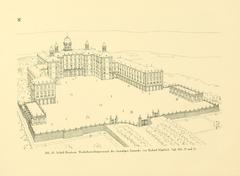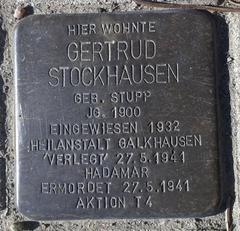Schnabelsmühle: Visiting Hours, Tickets, and Historical Sites in Bergisch Gladbach
Date: 04/07/2025
Introduction
Schnabelsmühle in Bergisch Gladbach, Germany, is a symbol of the city’s industrial heritage and its dynamic urban evolution. Once home to the region’s first documented paper mill, Schnabelsmühle played a pivotal role in establishing Bergisch Gladbach as a major center for papermaking and innovation (Stiftung Zanders). Today, the area seamlessly blends history, culture, and sustainability—offering public spaces, modern infrastructure, and green initiatives like the Bürgerwald (Citizen’s Forest). This comprehensive guide details Schnabelsmühle’s origins, cultural legacy, practical visitor information, and the best ways to explore the area’s rich heritage and contemporary attractions.
Table of Contents
- Historical Overview
- Cultural and Social Significance
- Modern Urban Renewal
- Visiting Schnabelsmühle
- Key Attractions and Visual Highlights
- Events and Local Culture
- Frequently Asked Questions (FAQ)
- References and Further Reading
Historical Overview
Origins and Early Development
Schnabelsmühle’s history traces back to the late 16th century when the Strunde Valley became a hub for water-powered mills. In 1582, the first documented paper mill on the Strunde River was established here, marking the start of Bergisch Gladbach’s transformation into a center for paper manufacturing (Stiftung Zanders). The Strunde, known as “the hardest-working stream in Germany,” soon saw dozens of mills, with Schnabelsmühle among the most significant in shaping the region’s industrial future.
The Rise of the Zanders Dynasty
A turning point came in 1822 when Johann Wilhelm Zanders acquired a stake in Schnabelsmühle, eventually founding the Zanders paper company after becoming sole proprietor in 1829. The Zanders family expanded operations by acquiring other mills, including Gohrsmühle and the Dombach mill, further solidifying Bergisch Gladbach’s standing in the German paper industry (Stiftung Zanders). Dombach mill’s installation of the city’s first paper machine in 1843 and the subsequent growth of the Zanders group underscored the area’s role as a cradle of industrial innovation.
Industrialization and Urban Transformation
The 19th and early 20th centuries brought rapid industrialization. With mechanized papermaking (notably the 40-meter-long PM4 machine in 1889), Schnabelsmühle and neighboring mills propelled economic growth and urban expansion (The Crazy Tourist). Today, the legacy of this era is preserved at the Papiermuseum Alte Dombach, Germany’s largest museum dedicated to papermaking, where visitors can explore the evolution from water-powered mills to industrial-scale production (The Crazy Tourist).
Cultural and Social Significance
Schnabelsmühle’s impact goes beyond industry. The prosperity generated by the mills spurred civic growth, cultural institutions, and social organizations. The Zanders family, especially Maria Zanders, contributed to the city’s cultural landscape by founding the Villa Zanders art museum (Der Weltreisender). The area’s history is intertwined with community, education, and the arts, shaping the identity of Bergisch Gladbach.
Modern Urban Renewal
In recent decades, Schnabelsmühle has been transformed through urban renewal projects that balance heritage with contemporary needs. The original mill structures have given way to infrastructure like the Turbokreisel roundabout—a major traffic hub and city gateway (Greenbox). The roundabout’s “floating” ring sculpture, inspired by a paper roll, is a modern tribute to the city’s industrial roots and values of unity and collaboration.
A highlight of this transformation is the Bürgerwald, a living urban forest inaugurated in 2021. Through tree sponsorships, residents and organizations contribute to a vibrant green space, underscoring the city’s commitment to sustainability and participatory urban planning (Bürgerwald Bergisch Gladbach). The Bürgerwald is both a natural retreat and a symbol of environmental stewardship.
Visiting Schnabelsmühle
Hours, Tickets, and Tours
- Schnabelsmühle Public Space: Open year-round, accessible at all times, no admission fee.
- Papiermuseum Alte Dombach: Tuesday–Sunday, 10:00 AM–5:00 PM (closed Mondays and public holidays). Entry is approx. €5–€7 for adults, with discounts for seniors, students, and groups. Children under 6 enter free.
- Bürgerwald: Open daily, no entrance fee.
- Guided Tours: Available at the Papiermuseum and for historic mill sites by appointment; check the museum’s website for schedules.
Accessibility and Directions
- Wheelchair Access: Both the museum and Bürgerwald offer wheelchair-accessible paths and facilities.
- Public Transport: Schnabelsmühle is near the city center and readily reached via the Bergisch Gladbach S-Bahn station and several bus lines.
- Parking: Ample parking is available at RheinBerg Galerie and municipal lots nearby.
- Cyclists: Dedicated bike lanes lead into the area; observe roundabout rules for safety (in-gl.de).
Visitor Tips
- Pair your visit with a walk along the Strunde River to discover other historic mill sites.
- Visit during local festivals or city events for a lively atmosphere.
- For tours and current event information, consult the official city website.
Key Attractions and Visual Highlights
- Bürgerwald: A green space symbolizing community and sustainability, ideal for relaxing walks and nature photography.
- Suggested image alt text: “Bürgerwald green space at Schnabelsmühle in Bergisch Gladbach”
- Turbokreisel Roundabout: The “floating” ring sculpture, referencing the city’s papermaking heritage.
- Suggested image alt text: “Floating ring paper roll sculpture at Schnabelsmühle roundabout”
- Papiermuseum Alte Dombach: Exhibits of historic machinery and the story of the Zanders dynasty.
- Suggested image alt text: “Papiermuseum Alte Dombach showcasing traditional papermaking machinery”
For more visuals and interactive planning tools, visit museum and tourism websites.
Events and Local Culture
Schnabelsmühle is a hub for city festivals, cultural events, and environmental campaigns. The Bürgerwald regularly hosts tree-planting ceremonies, educational workshops, and guided tours (Bergisches Wanderland). The area’s transformation is celebrated in citywide festivals, often held at nearby Konrad-Adenauer-Platz and during the Bergische Wanderwochen—highlighting local history, hiking, and community spirit.
Frequently Asked Questions (FAQ)
What are Schnabelsmühle’s visiting hours?
Schnabelsmühle is open year-round, accessible at all times. Papiermuseum Alte Dombach is open Tuesday–Sunday, 10:00 AM–5:00 PM.
Is there an entrance fee?
The public spaces and Bürgerwald are free; the Papiermuseum charges €5–€7 for adults.
Are guided tours available?
Yes, at the Papiermuseum and by arrangement for historic sites. Check online for availability.
Is the area accessible for people with disabilities?
Yes, paved paths and facilities ensure accessibility.
How do I get there?
Schnabelsmühle is centrally located in Bergisch Gladbach, near public transport hubs and with ample parking.
References and Further Reading
- Stiftung Zanders – History of the Zanders Paper Company
- The Crazy Tourist – 15 Best Things to Do in Bergisch Gladbach, Germany
- Der Weltreisender – 15 Best Activities in Bergisch Gladbach, Germany
- Greenbox – Stadteingang Schnabelsmühle Bergisch Gladbach
- Bürgerportal Bergisch Gladbach – Stadtgrün eröffnet den Bürgerwald an der Schnabelsmühle
- Bürgerwald Bergisch Gladbach – Official City Website
- Bergisches Wanderland – Schnabelsmühle und Gohrsmühle am fleißigsten Bach Deutschlands
Conclusion
Schnabelsmühle is more than a historical site—it is a vibrant urban space that honors Bergisch Gladbach’s papermaking legacy while embracing sustainability and community engagement. Visitors can immerse themselves in centuries of history, experience contemporary urban design, and participate in environmental initiatives. Whether you are interested in industrial heritage, green spaces, or cultural events, Schnabelsmühle offers a rewarding and multifaceted experience.
To deepen your visit, explore related attractions like the Papiermuseum Alte Dombach, Villa Zanders, and the scenic Strunde River trails. For guided tours, up-to-date events, and audio experiences, download the Audiala app and follow official tourism channels.
Ready to explore Schnabelsmühle? Download the Audiala app for guided audio tours and insider tips to enrich your visit!

